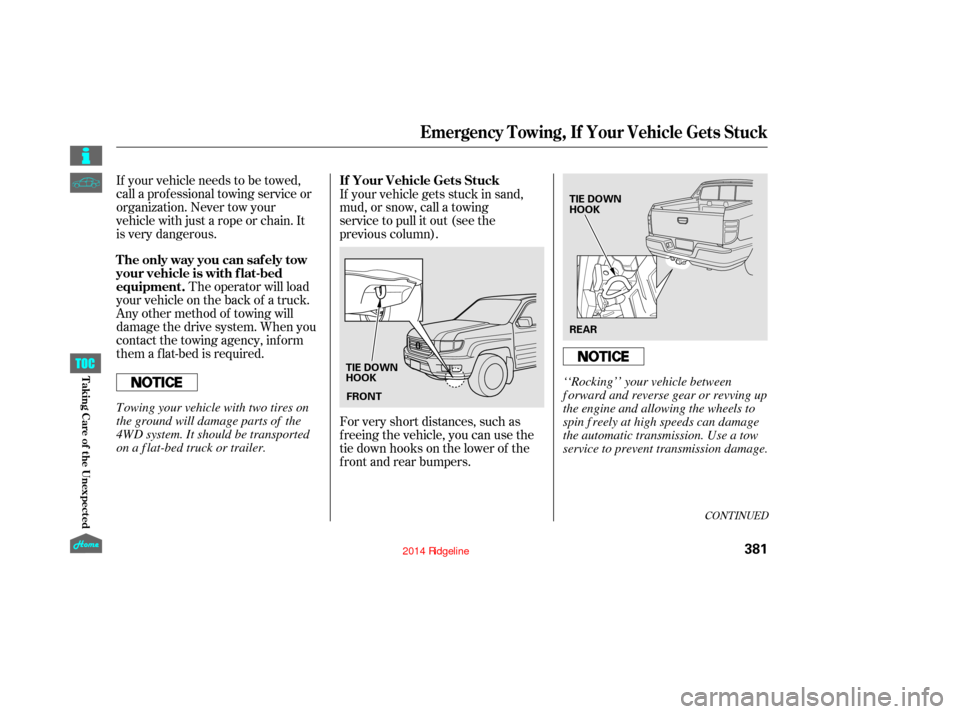Page 75 of 422

This indicator normally
comes on for a few seconds
when you turn the ignition switch
to the ON (II) position.You will also see a ‘‘CHECK VSA
SYSTEM’’ message on the multi-
inf ormation display (see page ).
This indicator normally comes on f or
a f ew seconds when you turn the
ignition switch to the ON (II)
position. If it comes on at any other
time, there is a problem in the 4WD
system. Take the vehicle to your
dealer to have it checked.
If the indicator blinks while driving,
the VTM-4 fluid temperature is too
high. Pull to the side of the road
when it is saf e, shif t to Park, and let
the engine idle until the indicator
goes out. This indicator has two f unctions:
It flashes when VSA is active (see
page ).
If it comes on and stays on at any
other time, there is a problem with
the VSA system. Take your vehicle
to a dealer to have it checked.
Without VSA, your vehicle
still has normal driving ability, but
will not have VSA
traction and stability enhancement.
For more information, see
page . 91
1.
2. 289
288
On models with navigation system
Instrument Panel Indicators
Vehicle Stability Assist
(VSA ) System Indicator
VTM-4 Indicator
70
Continuing to drive with the VTM-4
indicator blinking may cause serious
damage to the system.
12/08/09 16:08:27 31SJC670_077
Inst rument s and Cont rols
Page 270 of 422

This section gives you tips on
starting the engine under various
conditions, and how to operate the
automatic transmission. It also
includes important inf ormation on
parking your vehicle, the braking
system, the Variable Torque
Management
4-wheel drive
(VTM-4
) system, the vehicle
stability assist (VSA
), aka
Electronic Stability Control (ESC),
system, the tire pressure monitoring
system (TPMS), and f acts you need
if you are planning to tow a trailer or
drive of f -highway. ........................
Driving Guidelines .266
........................
Preparing to Drive .267
.......................
Starting the Engine .268
..............
Automatic Transmission . 269
Variable Torque Management
...........
4WD (VTM-4) System . 274
Tire Pressure Monitoring System ......................................
(TPMS) .276
...........................................
Parking .284
.............................
Braking System .286
...............
Anti-lock Brakes (ABS) . 287
Vehicle Stability Assist (VSA
),
aka Electronic Stability Control .......................
(ESC), System .288
.................
Towing Weight Limits . 291
..........
Towing Weight Guidelines . 293
...........................
Towing a Trailer .294
Of f -Highway Driving ..................................
Guidelines .304
Driving
265
12/08/09 16:34:17 31SJC670_272
Page 386 of 422

CONT INUED
If your vehicle needs to be towed,
call a professional towing service or
organization. Never tow your
vehicle with just a rope or chain. It
is very dangerous.The operator will load
your vehicle on the back of a truck.
Any other method of towing will
damage the drive system. When you
contact the towing agency, inf orm
them a f lat-bed is required. If your vehicle gets stuck in sand,
mud, or snow, call a towing
service to pull it out (see the
previous column).
For very short distances, such as
f reeing the vehicle, you can use the
tie down hooks on the lower of the
f ront and rear bumpers.
Emergency Towing, If Your Vehicle Gets Stuck
The only way you can saf ely tow
your vehicle is with f lat-bed
equipment.
If Your Vehicle Gets Stuck
381
FRONT
REAR
TIE DOWN
HOOK TIE DOWN
HOOK
‘‘Rocking’’ your vehicle between
f orward and reverse gear or revving up
the engine and allowing the wheels to
spin f reely at high speeds can damage
the automatic transmission. Use a tow
service to prevent transmission damage.
Towing your vehicle with two tires on
the ground will damage parts of the
4WD system. It should be transported
on a f lat-bed truck or trailer.
12/08/09 16:49:20 31SJC670_388
T aking Care of t he Unexpect ed